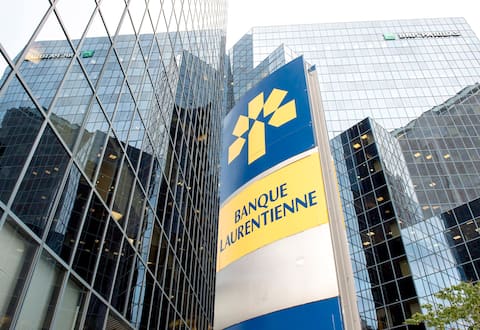If the Bank of Canada continues to raise its key rate, it’s because the Canadian economy is running too smoothly for its liking! Following Wednesday’s hike, another 25 basis point hike is expected next month, bringing our central bank rate to 5%.
But what about the fears of falling into recession that economists were brandishing just a few months ago? They seem to have disappeared. But let’s stay tuned. And here’s why.
Hardly anyone predicted that key central bank rates would collapse completely to almost 0% during the worst times of the COVID-19 pandemic. And since the end of the main health measures in March 2022, hardly anyone has predicted that central banks would multiply rate hikes at such a frantic pace.
What’s more, despite the very sharp increase in key rates in the space of barely 15 months, central banks have not yet succeeded in containing inflationary pressures.
If the economy as a whole continues to grow at a good pace and inflation persists, it is because another large portion of households continues not to skimp too much on spending despite the sharp rises in prices and rising interest rates.
During this time, on the other hand, the less fortunate households pull the devil by the tail and get into more and more heavily indebtedness. They are the ones who increasingly deprive themselves of what is strictly necessary to survive.
Apart of course from the top 10%, the rest of the population will unfortunately end up suffering serious financial consequences. It cannot be that prices and rates have risen so much without affecting the wallets of the majority of households.
Mortgages
Mortgage rates posted by banking institutions have exploded in the space of barely 15 months.
For every $100,000 of mortgage amortized over 25 years, here is the increase in monthly payment that the rate increase caused for the three most popular terms.
- The one-year term increased from 2.79% to 6.94%, thus making the monthly payment jump to $696.72, up from $233.66 (+ $2804 per year)
- The three-year mortgage term saw its rate climb from 3.49% to 6.40%. The monthly payment thus jumped to $663.77, or $165.03 more (+ $1,980 per year).
- The five-year term shows a rate of 6.49%, compared to 4.79% in March 2022. The monthly payment now reaches $669.72, a jump of some $100 (+ $1,200 over one year).
Other loans
Whatever the category, all loans today cost enormously more.
One need only look at the evolution of the prime rate to realize the extent of the “damage” that the dramatic rise in rates has caused.
The prime rate is the interest rate that commercial banks charge their most creditworthy business customers. The prime rate also serves as the reference rate from which various variable and fixed rate loans are negotiated.
The prime rate now stands at 6.95%, compared to just 2.45% in March 2022. This suggests that rates on various personal and business loans have exploded by at least 4 .5 percentage points.
Borrowing money from your credit union or bank today can cost us 11-15% in interest charges. Of course, that’s less than the 21% or more that we charge on credit card balances or overdraft amounts generated by our debit cards on bank accounts.
Tip: Pay off your credit card balances and bank account overdrafts as much as possible.
Automotive
Want to change car? You should know that the days of car financing at very low interest rates are over.
Buying or leasing a new vehicle now costs 7 to 10% in interest rates at car dealerships.
Advice
- If it is not already done, it would be time to make a budget according to its means and above all, to respect it.
- Given the surge in mortgage rates, households having to renegotiate their mortgage should favor the short term, to give themselves the chance to take advantage of the possible return to lower rates!
- Take out your calculator and perform all the calculations required to establish how much the final bill for the car you want will be. And ask yourself if you can afford it and if it is really urgent to change your car this year.
Rising interest rates are (also) happy
Photo archives, Pierre-Paul Poulin
Laurentian Bank’s head office in Montreal. Laurentian is one of the most generous banking institutions right now when it comes to GIC interest rates.
The spike in the Bank of Canada’s key rate is not just making borrowers unhappy.
She also makes people happy.
Winning savers
And I named the savers whose bank accounts are full of cash.
After falling slightly in recent months, the interest yield offered on the range of GICs (guaranteed investment certificates) and term savings investments available in banking institutions has resumed its ascent.
The most generous
The most generous banking institutions are:
- One-year GIC: Laurentian Bank (5.12%); Peoples Trust (5.10%); Tangerine (5.10%), Bank EQ (5.10%).
- Three-year GIC: Equitable Bank (4.95%); HomeEquity Bank (4.94%); CDN Western Bank (4.92%); ICICI Bank (4.90%); Laurentian Bank (4.75%).
- Five-year GIC: Canadian Tire Bank (4.68%); Equitable Bank (4.70%); CDN Western Bank (4.68%); HomeEquity Bank (4.71%); Laurentian Bank (4.62%); Bank EQ (4.65%).
The poorest
For their part, the major Canadian banks are less generous with respective returns of 4.55% on one-year GICs, 4% over three years and 3.95% over five years.
At Desjardins, we offer 4.5% for one-year term savings and 3.85% for three and five years.
A helpful reminder…
Tip: know that it is generally possible to obtain a slightly better return from the big banks and from Desjardins.
How ?
By reminding them of all the banking business you do there!
Unfortunately, Épargne Placements Québec has been rather stingy these days, with barely a yield of 4.25% for the one-year fixed-rate bond and only 3.85% for the three-year and of five years.

